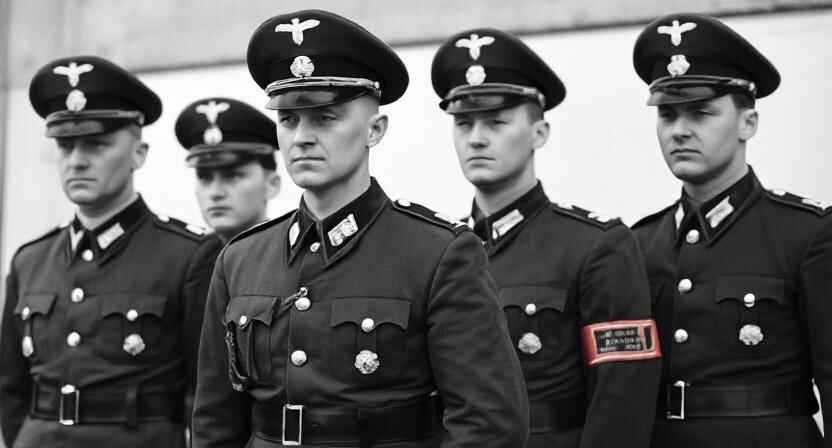
Schutzstaffel, or SS, turned into one of the maximum infamous paramilitary devices of Nazi Germany, with a strict hierarchy, specific uniforms, and heavy engagement within the conflict. The SS ranks went from simple enlisted troops to top-degree officials who participated in army motions in addition to administrative responsibilities. In this article, we are going to look at the ranks, hierarchy, and uniforms of the SS, giving you an idea of how the organization was structured.
Structure of the SS Ranks
SS was organized in various branches, mainly the Allgemeine SS (General SS), Waffen-SS (Armed SS), and the SS-Totenkopfverbände (Death’s Head Units). The grading system was separated from the Wehrmacht (German Army) but held a paramilitary rank pattern with other military staff.
- Enlisted Ranks (Mannschaften)
The enlisted ranks made up the bulk of the SS, carrying out ground-level tasks, such as policing, combat, and administrative work. These were the lowest in the hierarchy:
SS-Schütze (SS Private): The lowest rank for new entrants.
SS-Oberschütze (Senior Private): Given after some experience within the SS.
SS-Sturmmann (Storm Trooper): A higher rank than private, awarded to more experienced soldiers.
SS-Rottenführer (Section Leader): A corporal-equivalent rank that led small units.
- Non-Commissioned Officers (Unterführer)
Non-commissioned officers (NCOs) have been liable for retaining discipline and commanding small squads of soldiers. Their ranks were:
SS-Unterscharführer (Junior Squad leader): equivalent rank to a sergeant.
SS-Scharführer (Squad chief): greater senior sergeant, in fee of training and area.
SS-Oberscharführer (Senior Squad leader): equivalent to a body of workers sergeant.
SS-Hauptscharführer (grasp Sergeant): Senior NCO position with heavy obligation.
SS-Sturmscharführer (Assault Master Sergeant): Most senior enlisted rank short of officer rank.
- SS Officer Ranks (Führer Grades)
Rank holders in the SS were awarded the suffix “Führer,” which means leader. They held ranks equal to army officers and were tasked with commanding troops as well as carrying out SS policy.
SS-Untersturmführer (Second Lieutenant): Initial officer rank.
SS-Obersturmführer (First Lieutenant): Commanding a little larger unit than second lieutenants.
SS-Hauptsturmführer (Captain): Quite often commanding companies.
SS-Sturmbannführer (Major): An intermediate officer rank.
- High Command (SS General Officers)
The highest SS ranks belonged to senior officials who commanded divisions, policies, and important military operations:
SS-Obersturmbannführer (Lieutenant Colonel): A senior area officer.
SS-Standartenführer (Colonel): Commander of regiments.
SS-Oberführer (Senior Colonel/Brigadier): Intermediate rank among colonel and standard.
SS-Brigadeführer (Brigadier General): First popular-grade rank.
SS-Gruppenführer (main fashionable): Equal to a department commander.
SS-Obergruppenführer (Lieutenant general): Greater than a major widespread.
SS-Oberstgruppenführer (Colonel favored): Closest to the top of the SS hierarchy.
Reichsführer-SS (SS supreme Commander): The top rank, which turned into occupied via Heinrich Himmler.
SS Uniforms: Iconic and Distinctive
The SS uniforms were meant to convey power and authority, with their black, gray, and field-green hues becoming symbols of Nazi Germany.
Early SS Uniforms (Black): The authentic SS uniform, with its black tunic, peaked cap, and silver insignia, changed into one of the maximum identifiable clothes.
Waffen-SS combat Uniforms: area-grey uniforms like the ones of the Wehrmacht had been employed in combat regions.
SS Camouflage Uniforms: Waffen-SS troops brought with them advanced camouflage smocks for use in battle.
High-Command Dress Uniforms: High-ranking officers wore highly ornamented uniforms complete with insignia to reflect rank.
SS Ranks and Uniforms: A Lasting Impact
Although it has its black past, the SS continues to be a prominent area of study among collectors and historians. The SS organizational structure, rankings, and attire were vital for the military and administrative efforts in Nazi Germany. Today, the reenactors, collectors, and historians analyze these factors for better knowledge about World War II history.
To all interested in historical uniforms and war memorabilia, original reproductions of SS uniforms and other World War II information are available on Paddelaters, keeping history alive and remembered.







